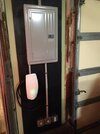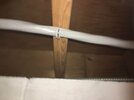Looks just like my install (I’m in central NJ). I’m guessing it’s the same installer - RF Electric. They were awesome to deal with and the install is very clean. No issues so far and definitely getting the full 48 amps.Kevin
My MY is on order with a EDD now May 31st to June 28th 2022.
My HPWC was installed yesterday in my garage with roughly 150 ft of #2 Aluminum 4 conductor cable from my 200 Amp breaker panel in my basement. I decided to use a Tesla recommended electrician and am very glad that I did. I have a 125 amp sub panel in my garage. Although a 100 amp sub panel was in the estimate I guess they were out of stock so I ended up with a 125 amp 12 slot sub panel with a double 60 amp breaker. A permit was applied for and I'm sure their excellent neat and professional work that they did will pass inspection.
As someone pointed out in another thread if those that do the work themselves with no permit, no licensed electrician, and if there is ever a fire the insurance company will most likely deny a claim?
I decided that I was unwilling to take any chances. My nephew will be stopping by next week with his 2021 MY so I can test out my wall charger to confirm the promised 48 amp charge rate prior to my Delivery DD.
Welcome to Tesla Motors Club
Discuss Tesla's Model S, Model 3, Model X, Model Y, Cybertruck, Roadster and More.
Register
Install the app
How to install the app on iOS
You can install our site as a web app on your iOS device by utilizing the Add to Home Screen feature in Safari. Please see this thread for more details on this.
Note: This feature may not be available in some browsers.
-
Want to remove ads? Register an account and login to see fewer ads, and become a Supporting Member to remove almost all ads.
You are using an out of date browser. It may not display this or other websites correctly.
You should upgrade or use an alternative browser.
You should upgrade or use an alternative browser.
DIY Install of NEMA 14-50 receptacle
- Thread starter kevinf1990
- Start date
rodmacpherson
Member
You made a good point with respect to teh advantages of a wall conector vs UMC, however, the cost of upsizing the wire from a gauge that can handle 40A to a gauge that can handle 60A is not insignificant,I suggest you consider the Wall Connector instead, the 14-50 is not as cheap was you might think. A quality outlet will run you about $80, you need a GFIC breaker that adds $100+, and you need to order a 14-50 adpater for the mobile connector, another $45. Add in some sort of cable management system for say $30 and your total is $255. The Wall Connector is $550 + a $10 breaker, which makes the total just $300 more. What do you get for that extra $300
And I would definatly replace the wire with copper!
- The ability to charge at 48A (on a 60-amp circuit) instead of 32A
- You get to keep the mobile connector in the car so it is not forgotten when needed
- If you add a 2nd Wall Connector at a later date, power sharing is already built in
- Firmware updates to the connector, power sharing was recently added via a firmware update
If you stay with your plan to run 40-amps to a 14-50 outlet, be sure to lable the outlet as 40-amps
If 32A is enough to cover your day to day use, using that $300 saved on the install to instead buy a second Mobile Connector might be worth while, and the money saved on the wire could go toward a set of adapters to go with that second UMC for every possible plug you might encounter on the road.
ATPMSD
Active Member
I suggest it is still better off with the WC then buying a 2nd UMC. The WC will deliver a 40A charge rate on a 50A circuit. Also, if you install a 14-50 outlet you need 6/3 wire, whereas the WC requires only 6/2 wire, so you can save on wiring as well.You made a good point with respect to teh advantages of a wall conector vs UMC, however, the cost of upsizing the wire from a gauge that can handle 40A to a gauge that can handle 60A is not insignificant,
If 32A is enough to cover your day to day use, using that $300 saved on the install to instead buy a second Mobile Connector might be worth while, and the money saved on the wire could go toward a set of adapters to go with that second UMC for every possible plug you might encounter on the road.
But…from what I have seen the cost of 4/2 wire is about the same as 6/3, so going to 60-amps is not a significant increase in wire cost. Your mileage, will of course, vary.
Last edited:
iluvmacs
Member
That is moot if you use NEMA 6-50 instead.Also, if you install a 14-50 outlet you need 6/3 wire, whereas the WC requires only 6/2 wire, so you can save on wiring as well.
iluvmacs
Member
This is refreshing to see mostly correct answers on an electrical installation thread for once  .
.
You should be able to tell rather easily if you can use the existing wire to pull in copper instead. Give it a tug on one end and see how easily it moves. If it was actually installed to code, it won't. Romex requires staples near junction boxes/panels, plus strain reliefs when going in and out of boxes (that part can be overcome but it's sometimes a pain). So likely the answer is no, you will need to open the drywall.
If you leave the Aluminum wire, yes you need the anti-oxidizing goo. Also, you will need to occasionally (1-2x per year) go check and re-tighten all terminal screws. Aluminum softens over time. I have had to do this with an outlet used at a family member's house (it overheated once rather significantly, tipping me off to this).
Yes, you need a receptacle that is rated for Al wire if you keep that. If it isn't, you can make a copper jumper and splice it (recommend Polaris connectors if you want some something small, or an outboard 60A non-fused disconnect (like those used for A/C units) if you want something cheap). The same is true if you put in an HPWC -- Gen 3 units are rated for copper only.
Make sure you use a GFCI breaker if your locale uses NEC 2017 or newer (most do). Not needed for HPWC. 40A is a fine choice for UMC usage. Agree that 60A is not going to be a good choice on a 125A service unless you do a load calc.
Finally, get it permitted and inspected per your AHJ.
You should be able to tell rather easily if you can use the existing wire to pull in copper instead. Give it a tug on one end and see how easily it moves. If it was actually installed to code, it won't. Romex requires staples near junction boxes/panels, plus strain reliefs when going in and out of boxes (that part can be overcome but it's sometimes a pain). So likely the answer is no, you will need to open the drywall.
If you leave the Aluminum wire, yes you need the anti-oxidizing goo. Also, you will need to occasionally (1-2x per year) go check and re-tighten all terminal screws. Aluminum softens over time. I have had to do this with an outlet used at a family member's house (it overheated once rather significantly, tipping me off to this).
Yes, you need a receptacle that is rated for Al wire if you keep that. If it isn't, you can make a copper jumper and splice it (recommend Polaris connectors if you want some something small, or an outboard 60A non-fused disconnect (like those used for A/C units) if you want something cheap). The same is true if you put in an HPWC -- Gen 3 units are rated for copper only.
Make sure you use a GFCI breaker if your locale uses NEC 2017 or newer (most do). Not needed for HPWC. 40A is a fine choice for UMC usage. Agree that 60A is not going to be a good choice on a 125A service unless you do a load calc.
Finally, get it permitted and inspected per your AHJ.
cmy4x4
Member
I thought that I read in the Tesla Wall Connector installation instructions: "Copper Wire Terminations Only"Kevin
My MY is on order with a EDD now May 31st to June 28th 2022.
My HPWC was installed yesterday in my garage with roughly 150 ft of #2 Aluminum 4 conductor cable from my 200 Amp breaker panel in my basement. I decided to use a Tesla recommended electrician and am very glad that I did. I have a 125 amp sub panel in my garage. Although a 100 amp sub panel was in the estimate I guess they were out of stock so I ended up with a 125 amp 12 slot sub panel with a double 60 amp breaker. A permit was applied for and I'm sure their excellent neat and professional work that they did will pass inspection.
As someone pointed out in another thread if those that do the work themselves with no permit, no licensed electrician, and if there is ever a fire the insurance company will most likely deny a claim?
I decided that I was unwilling to take any chances. My nephew will be stopping by next week with his 2021 MY so I can test out my wall charger to confirm the promised 48 amp charge rate prior to my Delivery DD.
howardnj
Member
My Gen 3 HPWC has copper wire terminations from the 100 Amp garage sub panel. The sub panel is fed with #2 aluminum four conductor cable from the 200 Amp basement panel that is roughly 150 feet away from my garage.I thought that I read in the Tesla Wall Connector installation instructions: "Copper Wire Terminations Only"
#2 aluminum cable is cheaper, lighter, easier to work with, perfectly acceptable to local electrical codes when properly terminated and torqued by qualified electricians.
Attachments
ATPMSD
Active Member
The use of Aluminum wire is OK provided if is terminated with Copper Wire, which is what the Wall Connector manual says.
Note:
This was also mentioned in post #25 above by @iluvmacs
Note:
- Aluminum has different coefficients of thermal expansion than copper – Termination systems need to take this difference into account. Thermal cycling of a termination can create voids leading to loose connections, which cause high-resistance terminations that get progressively worse over time.
This was also mentioned in post #25 above by @iluvmacs
Similar threads
- Replies
- 9
- Views
- 443
- Replies
- 2
- Views
- 633
- Replies
- 27
- Views
- 4K
- Replies
- 3
- Views
- 326




